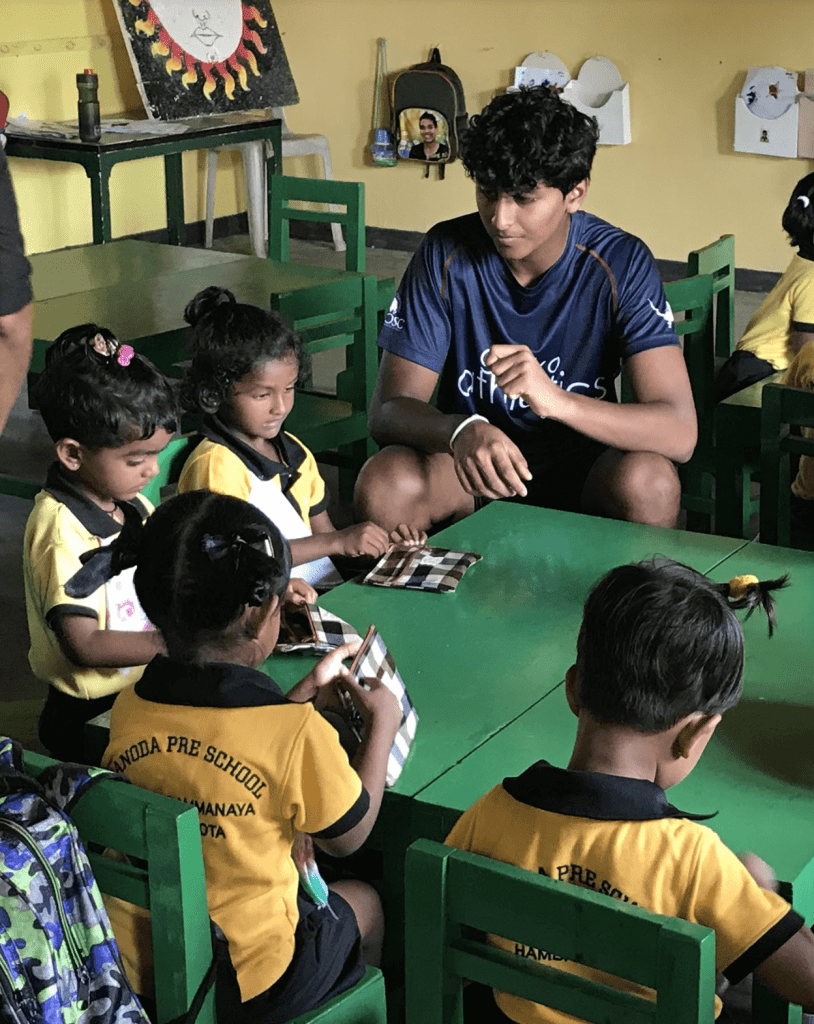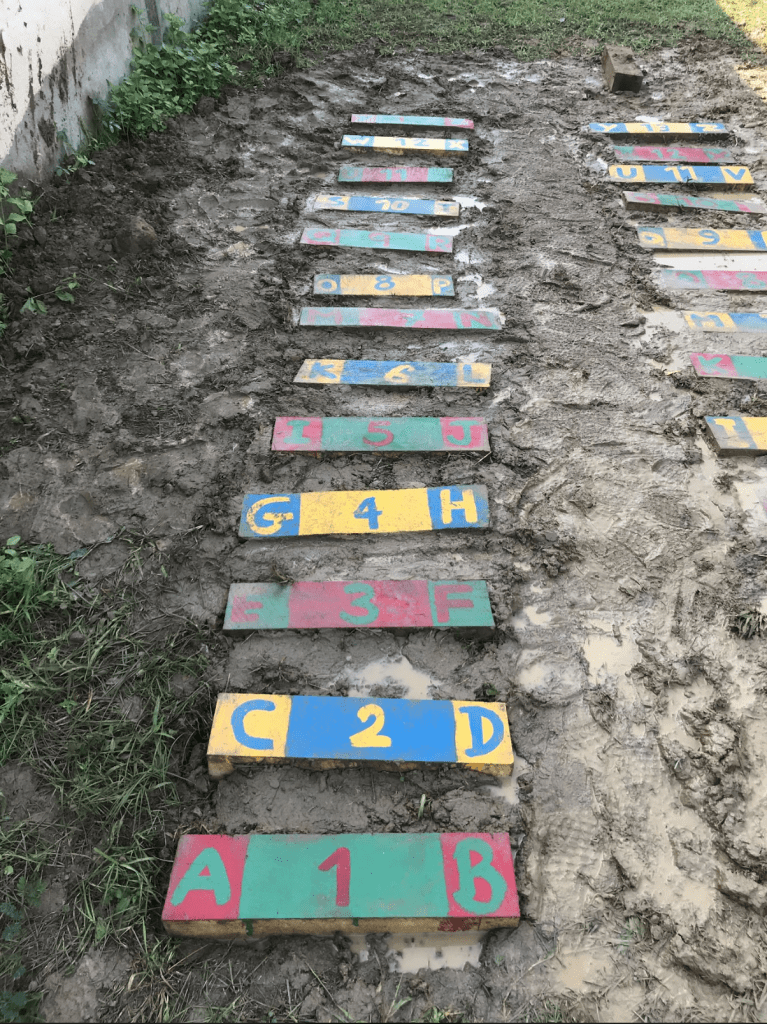Introduction:
The week without walls program allows students from grade 6 to 11 to leave colombo and experience the rich culture and myriad of activities offered by Sri lanka. The trips could range from exploring the ancient religious sites of Anuradhapura to canyoning and abseiling the waterfalls of Kithulgala. This year I selected the service trip to Hambantota to work with the Janoda foundations preschool. The trip engaged with the global issues of poverty and quality education. I was accompanied by a group of students and 2 chaperones.
Trip itinerary:
Monday – Arrive and settle in at the Janoda foundation. Get a tour of the hambantota area by Mr.Gamage
Tuesday -Begin teaching the students and work with them until 11. Start work on the railway track and work till 6.
Wednesday – Begin teaching the students and work with them until 11. Continue working till 4 (plan to finish the entire project) Go to the potters.
Thursday – if the track or mural isn’t complete finish it by 10, clean up and go to the Shangri-La. beach clean up at 1:30. Free time for the rest of the day
Friday – Lave Shangri-La and head back to
Day 1
The first day was essentially prep work for the building and teaching, as well as an incredible tour of the Hambantota area given to us by Mr.Karu. It was an eye opening experience as i had visited Hambanthota before but they were limited to the Shangri-la hotel. Our tour had a largely colonial theme, we visited an old british sea fort, one of few remaining worldwide. We also visited former british governors estates. It was a one of a kind experience as well were able to observe some of the largest influences to modern Sri Lankan Culture. After the tour we spent the rest of the day planning for the next day, and running the activities we planned on doing with the kids by the teachers. My teaching group for the next day was george and caoimhe. Our plan was to make paper crowns and play a color association game with the kids, in order to improve their cognitive abilities as well as teach them the basic colors.

(Myself and the Housing and Habitat Week Without walls group), Picture credits Ms. Fleming)
Day 2
The second day came around and with it our first day of working and teaching. At around 8 we met the students in the playground for an introduction and an exchange of names. Once we got familiar with the students we began our activities. One of the groups proposed a group parachute activity which turned out to be a major success. This kept the children occupied and engaged for over an hour of our 2 hours of teaching time. It was a great activity as we were able to keep the students engaged and then when we moved on they trusted us and were willing to participate in the crown and color association games.

(Making Paper Crowns with the students, Picture Credits – Ms. Fleming)
After this we began our building project. The plan was to build a railway track that the children could use for games and learning. In order to do this we would have to dig 3 uniform holes that were around 4m long. The depth of these holes was around 5 cm and the width was around 12 cm. Within these holes we would place wooden blocks that were evenly spaced apart. On these block would be letters and numbers. The building was by far the most challenging aspect of the trip as the hambantota area is notorious for the incredibly dry ground which proved a challenge to dig. It was also tuff getting the depth of the holes correct so that each of the blocks were level with one another. We worked for around 6-7 hours with a break in between for lunch.

(Myself, Oliver, Anish and Lenny working on the first hole for the railway track, Picture credits – Ms. Fleming & Mr. Rossberg)
Day 3
The 3rd day was essentially the same as the 2nd day. We played with the students for the last time. We redid the parachute activity from the day before as it turned out to be a major success. After this Caoimhe, George and myself worked on one of our other activities with the students which was making paper plate animal masks in order to develop their knowledge on animals and colors. Afterwards came the task of finishing the building. This was a challenge as it had rained heavily during the night and this continued until noon. As a result all of the holes had flooded and the ground around was incredibly muddy. Fortunately for us we had already inserted the blocks into the ground so they just had to be cleaned up but the third track still had to be built. This was an immense undertaking as all of the ground was loose and muddy. However we managed to finish ahead of scheduled and completed the entire project by 3pm. All that remained was to clean the blocks up and equipment the next day.

(Housing and Habitat group working through the rain to complete the railway project, Picture credits Ms. Fleming & Mr. Rossberg)

(Complete Railway Track prior to the next days touch ups, Photo credits Mr. Rossberg)
As we managed to finish the project early, we managed to squeeze in the visit to the potters on the 3rd day instead of the 4th. Again this was a culture shock to many of us as we got to see and partake in the traditional way of throwing pots. The husband and wife team that ran the pottery were incredibly skillful and it was clear they were masters of their craft. Doing it for the first time was a challenge for all of us. We worked in teams of 2, one person would spin the pottery wheel by hand while the other person used the momentum of the spinning wheel to shape the pot. My partner was Jaya, and overall I believe we decent job for first time poters. Overall it was a truly humbling and remarkable experience.

(Jaya and Myself throwing pots, Photo credits Ms. Fleming)
Day 4
The fourth day marked the end of our stay at the Janoda foundation. Unlike the previous 2 days, this thursday started off much slower and with less intensity. We weren’t teaching the students today so we could afford to get started on our remaining work a half and hour earlier. The tasks for today were to clean up the blocks so the letters, numbers and colors were visible, as well as attempt to secure the blocks further by removing as much excess water as well could, while securing empty crevices in between the blocks with mud and dirt. This didn’t take too long with 6 people working on it at the same time. Finishing the project completely felt incredibly rewarding. It was the first time that many of us had done any semi-large manual labour tasks, and given the added difficulty due to the rain, completing the project was surreal. It also marked the beginning of the “fun” portion of the trip as after we were done cleaning up the equipment, we were headed to the Shangri-La resort.

(completed clean railway track, Photo credits Ms. Fleming)
After packing up and heartfelt goodbye from Mr. Gamagay our group left for the Shangri-La. Once we arrived we settled into our rooms and descended on the buffet for lunch. The plan for the evening was to leave for a stretch of beach around 10 minutes from the hotel to do a beach cleanup. This cleanup was important as this beach is commonly used by local fisherman as a docking point for their boats, and as a result it is home to huge amounts of plastic and stray bits of fishing nets that are incredibly hazardous to the wildlife in the area. The activity was slated go onto late in the evening as the goal was to fill 12 large garbage bags with the litter on the beach. Once we arrived at the beach we were met by the blistering sun and a strong ocean breeze. Much to the surprise of the teacher and the hotel guide our group took this activity in stride, pairing up and filling bag after bag with piles of plastic and fishing net. Our work only took us around 1 and a half to 2 hours and upon completion the feeling was bitter sweet. Despite our efforts and the sheer volume of the litter we had collected the true scope plastic of the problem dawned on us and we realised that we had made barely a dent in beachs pollution. Personally I could no longer be ignorant to the problem as it was staring at me in 12 massive plastic bags. The scale of the issue made me understand that this had to be a global effort in order to reduce our carbon footprint and it started with little things i could change in my lifestyle that would make even a minute difference. I can honestly say that this beach cleanup had a lasting impact on me and i am very thankful that i participated.

(Results of our beach cleanup, Photo credits Ms. Fleming)
We arrived back at the hotel at around 3:30 and were given free time until dinner at 7, after dinner we were allowed more free time until lights out which was at 10:30. It was really nice after a week of hard work to be allowed to take the evening off in order to relax and enjoy the company of my group members.
Reflection
Overall I came away from this trip with a sense of achievement and development. It was so humbling to be able to give back to the community by working with students less fortunate than ourselves. It was also amazing to have had an opportunity to help benefit the environment. To conclude, I have been an OSC student all my life, and WWW has been a major part of my learning over the last few years. Going into DP marks the end this program for me, despite this I am very grateful that this trip is how I get to conclude the WWW program.
